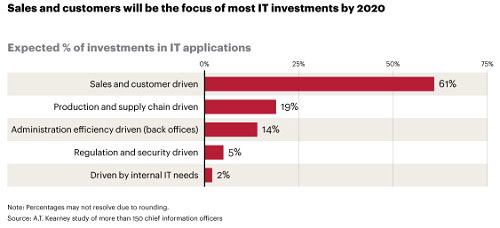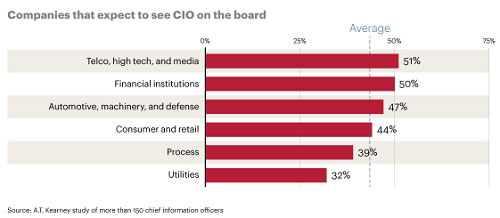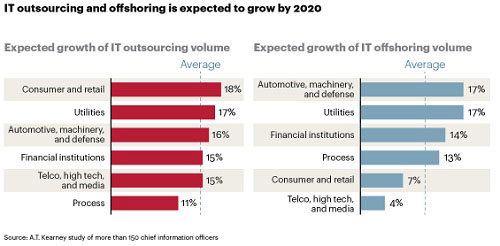A study focusing on IT in the year 2020 predicts many current tech employees will face a transition to external providers, training for new roles or layoffs. New jobs are likely to significantly outnumber reductions over the next seven years, but they'll require new talents and retraining may not be sufficient, according to consulting firm A.T. Kearney.

In-demand will be experts who understand IT, digital technologies and business, as well as those experienced in sales and customer-driven applications, which will dominate app development over the next seven years. The study is based on responses from 150 Chief Information Officers (CIOs) of global companies. The report,
IT 2020: Preparing for the Future, found that two-thirds of companies plan to invest more in IT between now and 2020, especially in sales and customer interactions. According to the study:
Nearly 85 percent of respondents say they foresee a significant increase over the next few years. Almost 75 percent say time pressure for implementing IT projects is also increasing, with the always complex time-to-market function becoming the key performance indicator. Sales- and customer-driven applications are becoming the main focus of IT investments, according to 61 percent of CIOs. Improving processes and automating production, once IT's main focus, are giving way to fostering customer relations via personalized marketing campaigns, data analytics, and online ordering systems as key IT functions.
Profiting From the Skills Deficit
[caption id="attachment_102046" align="aligncenter" width="500"]

Source: A.T. Kearney[/caption] The study reaffirmed that "there is always a need for experts who understand both IT and business, and that need is only going to grow." Already, there are not enough of those specialists to fill open positions and the study's authors say that gap is getting wider, especially outside English-speaking markets,
If the skills shortage is not addressed, business development will stall, and time-to-market requirements will go unmet. EMEA countries appear to have the most serious skills gap. Germany and France have a huge qualification deficit in the IT sector. In Germany alone, about 60,000 IT positions will remain unfilled until 2020 unless new efforts are made to attract and train business-minded IT personnel. The United States, Canada, and the United Kingdom are in a better position, thanks to their access to qualified workers, including those from India who speak the local language.
The study's implied advice to workers: Make sure you are highly qualified in both technology and solving business problems if you want to remain competitive in the job market.
CIOs Become More Important in Some Industries
At the top IT pay grade, the study found nearly 45 percent of respondents said they expect to have a CIO as a board member by 2020. Such a move, however, makes sense only in businesses and industries where IT is a key business driver.
According to our study, CIOs will more often (51 percent) be on the boards of telecommunication, media, and high-tech companies and financial institutions, where IT is a core business asset. In fact, Citigroup recently named former General Electric CIO Gary Reiner as an independent director and member of its board of directors. A smaller proportion of consumer and retail, process, and utility companies—where IT is mainly a support function—will have CIOs on their boards.
[caption id="attachment_102044" align="aligncenter" width="500"]

Source: A.T. Kearney[/caption] For the CIO's staff, however, the picture is less rosy. Outsourcing and offshoring are expected to continue to increase, with "mega-suppliers" like
Accenture and
SAP increasing their business as CIOs seek safe alternatives to in-house staffing. Jobs at those and similar companies will help offset losses in corporate IT shops. Offshoring, meanwhile, may see a shift from Asian suppliers to those in Eastern Europe, who are closer physically and may create less of a language barrier. [caption id="attachment_102045" align="aligncenter" width="500"]

Source: A.T. Kearney[/caption]
 In-demand will be experts who understand IT, digital technologies and business, as well as those experienced in sales and customer-driven applications, which will dominate app development over the next seven years. The study is based on responses from 150 Chief Information Officers (CIOs) of global companies. The report, IT 2020: Preparing for the Future, found that two-thirds of companies plan to invest more in IT between now and 2020, especially in sales and customer interactions. According to the study:
In-demand will be experts who understand IT, digital technologies and business, as well as those experienced in sales and customer-driven applications, which will dominate app development over the next seven years. The study is based on responses from 150 Chief Information Officers (CIOs) of global companies. The report, IT 2020: Preparing for the Future, found that two-thirds of companies plan to invest more in IT between now and 2020, especially in sales and customer interactions. According to the study:
 Source: A.T. Kearney[/caption] The study reaffirmed that "there is always a need for experts who understand both IT and business, and that need is only going to grow." Already, there are not enough of those specialists to fill open positions and the study's authors say that gap is getting wider, especially outside English-speaking markets,
Source: A.T. Kearney[/caption] The study reaffirmed that "there is always a need for experts who understand both IT and business, and that need is only going to grow." Already, there are not enough of those specialists to fill open positions and the study's authors say that gap is getting wider, especially outside English-speaking markets,
 Source: A.T. Kearney[/caption] For the CIO's staff, however, the picture is less rosy. Outsourcing and offshoring are expected to continue to increase, with "mega-suppliers" like Accenture and SAP increasing their business as CIOs seek safe alternatives to in-house staffing. Jobs at those and similar companies will help offset losses in corporate IT shops. Offshoring, meanwhile, may see a shift from Asian suppliers to those in Eastern Europe, who are closer physically and may create less of a language barrier. [caption id="attachment_102045" align="aligncenter" width="500"]
Source: A.T. Kearney[/caption] For the CIO's staff, however, the picture is less rosy. Outsourcing and offshoring are expected to continue to increase, with "mega-suppliers" like Accenture and SAP increasing their business as CIOs seek safe alternatives to in-house staffing. Jobs at those and similar companies will help offset losses in corporate IT shops. Offshoring, meanwhile, may see a shift from Asian suppliers to those in Eastern Europe, who are closer physically and may create less of a language barrier. [caption id="attachment_102045" align="aligncenter" width="500"] Source: A.T. Kearney[/caption]
Source: A.T. Kearney[/caption] 

